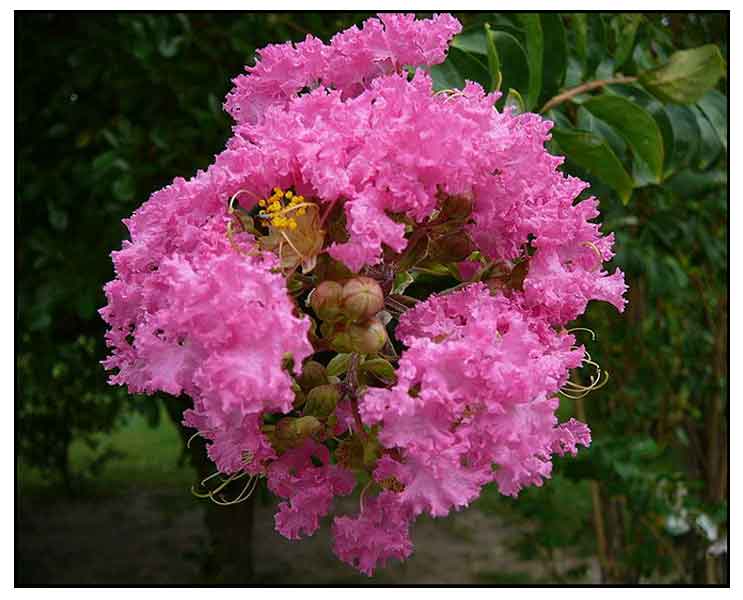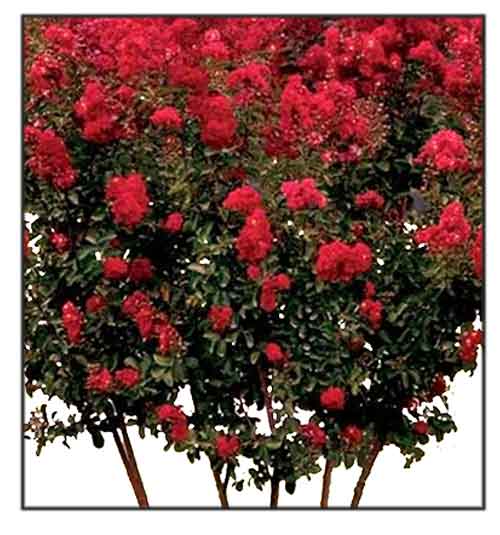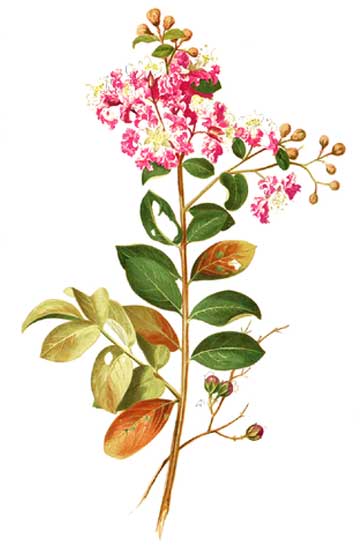 Gen info Gen info
- Lagerstroemia, commonly known as crape myrtle, is a genus of around 50 species of deciduous and evergreen trees and shrubs belonging to the family Lythraceae, also known as the loosestrife family.
- Etymology: The genus name honors Swedish botanist Magnus von Lagaertröm, a director of the Swedish East India Company, who supplied Carl Linnaeus with plants he collected. (20)
- The common name refers to the crepe-papery inflorescences and myrtle-like features of the bark and foliage.
Botany
• Melendres is a shrub growing up to 3 meters or less in height. Branches are slender, 4-angled, and narrowly winged. Leaves are entire, stalkless, obovate, elliptic-ovate to oblong-ovate, 4 to 8 centimeters long. Flowers are white, pink or purplish, about 4 centimeters in diameter, borne on small, terminal panicles. Capsules are globose-ovoid, about 1 centimeter long.
 • Shrubs or small trees, to 7 m tall. Branchlets slender, 4-angled or subalate, puberulous, glabrescent. Leaves sessile or with petiole to ca. 2 mm; leaf blade elliptic, oblong, obovate, or suborbicular, typically at least some suborbicular to obovate and mucronate, 2.5-7[-10] × 1.5-4 cm, papery to slightly leathery, glabrous or with slight indumentum on veins abaxially, lateral veins 3-7 pairs, base broadly cuneate to rounded, apex acute, obtuse with small mucro, or retuse. Panicles subpyramidal, 7-20 cm, puberulous, densely flowered. Floral tube 6-merous, 7-11 mm, smooth walled or obscurely to decidedly 6-ribbed, glabrous; sepals 3.5-5.5 mm, adaxially glabrous; annulus present; epicalyx absent. Petals purple, fuchsia, pink, or white, orbicular, 1.2-2 cm including claw 6-9 mm. Stamens 36-42, dimorphic. Ovary glabrous. Capsules ellipsoidal, 1-1.3 × 0.7-1.2 cm, 4-6-valved. Seeds including wing ca. 8 mm. (Flora of China) • Shrubs or small trees, to 7 m tall. Branchlets slender, 4-angled or subalate, puberulous, glabrescent. Leaves sessile or with petiole to ca. 2 mm; leaf blade elliptic, oblong, obovate, or suborbicular, typically at least some suborbicular to obovate and mucronate, 2.5-7[-10] × 1.5-4 cm, papery to slightly leathery, glabrous or with slight indumentum on veins abaxially, lateral veins 3-7 pairs, base broadly cuneate to rounded, apex acute, obtuse with small mucro, or retuse. Panicles subpyramidal, 7-20 cm, puberulous, densely flowered. Floral tube 6-merous, 7-11 mm, smooth walled or obscurely to decidedly 6-ribbed, glabrous; sepals 3.5-5.5 mm, adaxially glabrous; annulus present; epicalyx absent. Petals purple, fuchsia, pink, or white, orbicular, 1.2-2 cm including claw 6-9 mm. Stamens 36-42, dimorphic. Ovary glabrous. Capsules ellipsoidal, 1-1.3 × 0.7-1.2 cm, 4-6-valved. Seeds including wing ca. 8 mm. (Flora of China)
Distribution
- Introduced.
-
Cultivated in Manila and neighboring towns for ornamental purposes.
- Nowhere spontaneous.
- Native to Assam, Bangladesh, Cambodia, China, Himalaya, Hainan, Myanmar, Nepal, Taiwan, Vietnam. (11)
- Now planted in most warm and tropical regions.
 Constituents Constituents
- Biocolorants isolated from the fruits were found to be quercetin and apigenin.
- Study isolated two new biphenylquinolizidine alkaloids, 5-epi-dihydrolyfoline and its sterioisomer, dihydrolyfoline, along with lagerine, from the aerial parts of L. indica. (2)
- Aqueous methanol leaf extract yielded 2 natural products for the first time—brevifolin (15) and decarboxy ellagic acid (21) together with known polyphenolics: p-methoxy gallic acid methyl ester (1); Gallic acid (2); 3-O-methylgallate (3); Tellimagrandin (4); Nilocitin (5); 1,3-di-O-galloyl-4,6-hexahydroxydiphenoyl-β-4 C 1 -glucopyranose (6); 2,3-hexahydroxydip-henic acid-α/β-glucoside (7); Isovitexin (8); Vitexin (9); Iso-orientin (10); Orientin (11); Astralagin (12); Rutin (13); Apigenin-7-O-4 C 1 -β-D-glucoside (14); Catechin (16); Epicatechin (17); Luteolin-7-O-4 C 1 -β-D-glucoside (18); 3-methoxyellagic acid (19); Ellagic acid (20); Apigenin (22); Kaempferol (23); Luteolin (24) and Quercetin (25) (See study below) (9)
- Aerial parts of L. indica yielded four new biphenyl and biphenyl ether quinolizidine N-oxide alkaloids, 5-epi-dihydrolyfoline N-oxide (1), decamine N-oxide (2), lagerstroemine N-oxide (3), and lagerine N-oxide (4). (10)
- Leaf analysis yielded protein 22.53, carbohydrate 37.25, and ash contents 12.23 g% on dry wt. basis. (1)
- Phytochemical screening of leaf extracts yielded terpenoids, tannins, deoxysugars, saponins, phenolic compounds, and flavonoids.
(see study below) (13)
- Phytochemical screening yielded
active metabolites viz. anthraquinones, reducing sugars, terpenoids, flavonoids, saponins, tannins, alkaloids, and cardiac glycosides. (see study below) (15)
- In a phytochemical study of Lagerstroemia specie, y-sitosterol was the major component in all species at 14.70 - 34.44% (32.2% in L. indica). (See study below) (16)
- Purification of methanol extract of stems of L. indica yielded three new phenolic glycosides, stroside A-C (1-3), a new flavone derivative, lagerindiol (4), along with 15 known compounds (5-19). (see study below) (22)
- Study of EtOH extract of flowers of Lagerstroemia indica isolated a new pyrrole alkaloid, lagerindicine (1), along with four known compounds (2-5), namely: pterolactam, betulinic acid, oleanolic acid, and 24-methylenecycloartanol. (see study below) (24)
 Properties Properties
- Considered astringent, insecticidal, purgative, febrifuge, stimulant.
- Root considered detoxicant, diuretic and astringent.
- Studies have shown anti-inflammatory, antimicrobial, antithrombin, insecticidal, anticancer, antiulcer, stretch mark alleviating, hair growth promoting, hair loss preventive properties.
Parts used
Roots, bark, leaves, flowers.
Uses
Folkloric
- In India, decoction of roots considered astringent, used as gargle.
- Roots, leaves and flowers are purgative.
- Bark used as febrifuge and stimulant.
- Decoction of flowers used for treatment of colds. Flower paste applied to wounds and cuts. (12)
- In Iraq, decoction of bark and leaves used as laxative; seeds used as hypnotic. (17)
Others
- Charcoal: Charcoal made from it used in Japan for thickening laquer.
- Wood: Used a timber.
Studies
• Phytochemicals: High content of potassium, calcium, magnesium, phosphorus, sodium and sulfur present in the leaf. Study yielded alkaloids in high concentration, followed by tannins, cardiac glycosides, saponins, sterols, triterpenes and anthraquinones reducing compounds. (see constituents above) (1)
• Biphenylquinolizidine Alkaloids / Aerial Parts:Study yielded two new biphenylquinolizidine alkaloids, 5-epi-dihydrolyfoline and its sterioisomer, dihydrolyfoline along with lagerine, from the aerial parts of L. indica. Study evaluated the inhibitory effects of isolated compounds on rat lens aldose reductase. (2)
• Antithrombin: L. indica was one of seven of 30 plants of central Florida studied for antithrombin activity. In the bioassay used, the seven demonstrated activity of 80% or higher. (3)
• Natural Colorants: Biocolorants isolated from the fruits were found to be quercetin and apigenin. The dry samples exhibited good colour fastness to washing and perspiration. The colorants showed a potential source as dye for textile dyeing. (4)
• Anti-Inflammatory: Study evaluated the anti-inflammatory effect of LI on lung inflammation in ovalbumin-induced asthmatic mice. The LI extract inhibited increased cytokine concentrations, significantly inhibited leucocytosis and eosinophilia in bronchoalveolar lavage fluid and lung tissue samples, and inhibited the increase in mucus secretion by goblet cells. Results suggest the LI extract may be used as a valuable agent for treating allergic diseases such as asthma due to its anti-inflammatory property. (5) Study evaluated the anti-inflammatory effect of ethanolic extract of L. indica on airway inflammation in mice. Results showed inhibition of cytokine concentrations and suggests a potential agent for the treatment of allergic diseases such as asthma. (14)
• Insecticidal: The insecticidal activity of 14 varieties of Chinese plants were screened through diet-incorporated method against the larvae of Helicovepa armigera. The inhibition rate of Lagerstroemia indica was the highest among the treatments. (6)
• Biologic Activities: Aqueous methanol leaf extracts from two extraction methods (A & B) showed significant activities viz. anti-inflammatory, antipyretic, analgesic, antihyperglycemic, antioxidant and hepatoprotective. Extract B showed ore antihyperglycemic activity. (9)
• Biphenyl and Biphenyl Ether Quinolizidine N-oxide Alkaloids: Four new biphenyl and biphenyl ether quinolizidine N-oxide alkaloids. (See constituents above) The inhibitory effects of isolated compounds on rat lens aldose reductase (RLAR) were examined. (10)
• Antimicrobial / Leaves: Study evaluated the aqueous and methanol leaf extracts of L. indica and Annona reticulata against human bacterial pathogens viz., K. pneumonia, S. aureus, S. typhi, P. vulgaris, and P. aeruginosa. Results showed a wide spectrum of antibacterial activities against the test bacterial pathogens. (13)
• Antioxidant / Antimicrobial: Antimicrobial assessment was done against Gram-positive bacteria (B. subtilis, S. aureus), Gram-negative bacteria (P. aeruginosa, E. coli) and fungal strains (A. oryzae and A. niger). Maximum antibacterial potential was exhibited by PE extract of bark against B. subtilis and maximum antifungal potential against A. niger by chloroform extracts of bark and fruits at 40.33 ± 0.88 mm and 40.0 ± 1.15 mm, respectively. The petroleum ether extract exhibited highest values for total flavonoid content (1185.74 ± 0.01 µg/ml) and total phenolic contents (40.333 ± 0.23 µg/ml. The aqueous extract of bark exhibited highest DPPH% value (92.92 ± 0.08%). (see constituents above) (15)
• y-Sitosterol / Anticancer: In a phytochemical study of Lagerstroemia specie, y-sitosterol was the major component in all species at 14.70 - 34.44% (32.2% in L. indica). In vitro studies have supported the ethnomedical use of y-sitosterol against cancer through growth inhibition and cell cycle arrest on the apoptosis of cancer cells. Study (Endrini et al) showed y-sitosterol was cytotoxic against colon and liver cancer cell lines, an effect mediated by downregulation of c-myc expression and induction of apoptotic pathways. (16)
• Anti-Inflammatory / Anti-Reflux Esophagitis:
Study evaluated L. indica fruits for anti-inflammatory effects in LPS-induced Raw 264.7 cells and protection effects on reflux esophagitis in rats. The NO production and iNOS, COX-2, and NF-kB expression increased by LPS were inhibited by L. indica extracts. Results suggest ethanol extracts of L. indica fruits has potential as a nutraceutical through high anti-inflammatory and protection effects on reflux esophagitis. (18)
• Corosolic Acid: Refluxing of the ground leaves in methanol showed also two major peaks at tR = 2.433, 85.81%, and tR = 4.017, 8.53%. These two methods showed similar results but obtaining a 100% pure corosolic acid was not materialized. Results showed Lagerstroemia indica plant has much lower corosolic acid than Lagerstroemia speciosa. (19)
• Antiulcer / Leaves: Study evaluated the gastroprotective effect of methanolic extract of L. indica in an indomethacin-induced ulcer model in rats. Extract and omeprazole was administered for 21 days before induction of ulcer with indomethacin. Results showed significant (p<0.01) antiulcer effect in measures of pH, ulcer inhibition, and ulcer index. (21)
• Phenolic Derivatives / Anticancer / Stems: Purification of methanol extract of stems of L. indica yielded three new phenolic glycosides, stroside A-C (1-3), a new flavone derivative, lagerindiol (4), along with 15 known compounds (5-19). Isolated compounds were investigated for cytotoxicity against four human cancer cell lines, viz., A549 (non-small cell lung carcinoma), SK-OV-3 (ovary malignant ascites), SK-MEL-2 (skin melanoma), and HCT-15 (colon adenocarcinoma) using sulforhodamine B assay. Compounds 4 and 6 showed moderate toxicity against the cancer cell lines with IC50s of 16.59, 16.64, 17.26, and 8.83 µM for compound 4, and 6.51, 9.13, 11.38, and 5.87 µM, respectively. (22)
• Zinc Oxide Nanoparticles / Anticancer / Antimicrobial: Study reports on the synthesis of zinc oxide nanoparticles using L. indica. The ZnONPs showed antibacterial activity with MICs of88, 52, 79, and 72 µg/ml against Staphylococcus aureus, Escherichia coli, Pseudomonas aeruginosa, and Klebsiella pneumonia, respectively. MTT assay showed significant cytotoxic potential against MCF-7 and HeLa cells with IC50s at 36.28 and 30.10 µg/ml, respectively. The NPs showed reduction in mitochondrial membrane potential (MMP) and increased level of reactive oxygen species (ROS). (23)
• Cytotoxicity / Colon Cancer Cell Line / (HCT-116) / Flowers: Study of EtOH extract of flowers of Lagerstroemia indica isolated a new pyrrole alkaloid, lagerindicine (1), along with four known compounds (2-5). Compound 3 exhibited weak cytotoxicity against human colon cancer cell (HCT-116) with IC50 of 28.4. (see constituents above) (24)
• Hypoglycemic Effect / α-Glucosidase Inhibitory / Flowers: Study evaluated the hypoglycemic effects of various extracts from flowers of L. indica and L. indica f. alba by α-glucosidase inhibitory method in vitro and alloxan-induced diabetic mice model in vivo. Petroleum ether extracts, ethyl acetate extracts, and n-butyl alcohol extracts of LIF and LIAF all exhibited good α-glucosidase inhibitory activity in vitro. In vivo testing showed each dose group of LIF could significantly decrease (p<0.05, p<0.01, and p<0.001) fasting blood gliucose, total cholesterol, malondialdehyde done in diabetic mice and increase superoxide dismutase (SOD) level (p<0.05) in serum. Partial dose groups of LIAF could significantly (p<0.05) decrease TG, MDA, and increase liver glycogen content. Results suggest LIF and LIAF had effective preventive and therapeutic effects on diabetes. (25)
• Alleviating Effect on Stretch Marks / Flowers: Stretch marks (striae distensae: SD) are common linear scars of atrophic skin with disintegrating extracellular matrix (ECM) structures. Mast cell degranulation causes disruption of ECM in early SD lesions. Study evaluated the effects of LIFE (L. indica flower extract) on mast cell degranulation and the synthesis of ECM components in fibroblasts. LIFE inhibits adhesion of rat basophilic leukemia (RBL) cells, RBL-2H3 on fibronectin (FN) and expression of integrin, a receptor of FN, thereby reducing focal adhesion kinase (FAK) phosphorylation. Results demonstrate that LIFE suppress FN-induced mast cell activation and promotes synthesis of ECM component in fibroblast, which suggests potential as a cosmetic agent for treatment of SD (stretch marks) treatment. (26)
• Stimulation of Hair Growth / Prevention of Hair Loss: Effects of L. indica on hair growth have been studied in human hair follicle dermal papillary (hHFDP) cells and follicular organ culture ex vivo by cell proliferation assay. Study evaluated the potential of hair growth promotion and/or hair loss prevention by L. indica extract. Results suggest L. indica extract prevents hair loss and stimulates hair growth by regulating the Wnt-ß-catenin, JAK3-STAT6, and TGF-ß1-Smad signaling pathways, and has potential for development as a novel functional cosmetic for preventing hair loss. (27)
Availability
- Cultivated.
|

![]()





 Constituents
Constituents Properties
Properties